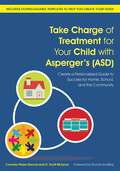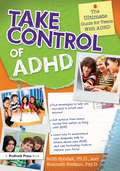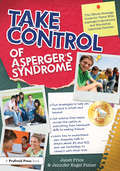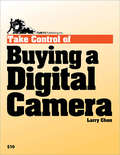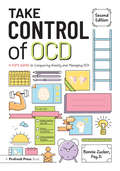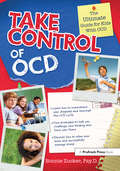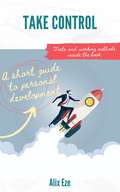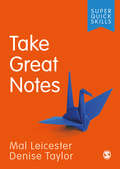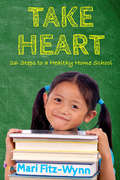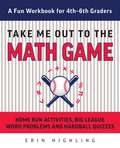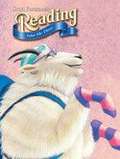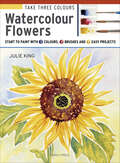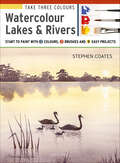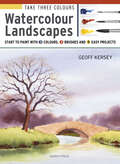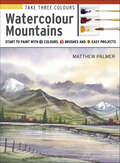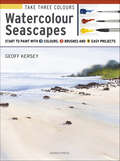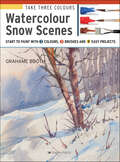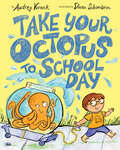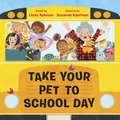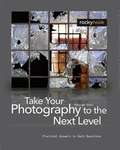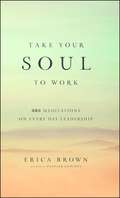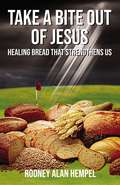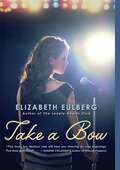- Table View
- List View
Take Charge of Treatment for Your Child with Asperger's (ASD): Create a Personalized Guide to Success for Home, School, and the Community
by Shonda Schilling Cornelia Pelzer Elwood D. Scott McleodEquipping you with the knowledge and tools to become an effective case manager for your child, this book provides straightforward, practical instructions to create a comprehensive guide to your child's unique ASD profile. The individualized guide will: - Provide information about your child's unique profile for anyone who needs it - Serve as a toolbox and teaching template for your child's teachers and support team, with effective strategies to use with him or her - Be an instruction booklet for your child, helping him or her to thrive at home, school and in the community - Act as a case management road map to help you support your child and collaborate with teachers and service providers. The book includes checklists and worksheets, which can also be accessed online, so that you can easily create a personalized guide for your child with autism aged 5-14.
Take Control of ADHD: The Ultimate Guide for Teens With ADHD
by Ruth Spodak Kenneth StefanoTake Control of ADHD: The Ultimate Guide for Teens With ADHD helps teens take control of their disorder and find success in school and in life. By creating the “ADHD Attention Profile” discussed in the book, readers will recognize how ADHD affects them, discover coping strategies and technology tools to improve their focus, and develop a self-advocacy plan they can use immediately. The book presents the latest research and information on ADHD in a conversational style that teens can understand easily, allowing them to develop a better understanding of their disorder. By including suggestions from teens with ADHD, the authors offer tons of advice, information, and ideas for students, from students just like them. This handy guidebook is sure to help teens with ADHD learn to refocus their attention and find success in school and beyond!Ages 12-18
Take Control of Asperger's Syndrome: The Official Strategy Guide for Teens With Asperger's Syndrome and Nonverbal Learning Disorder
by Janet Price Jennifer Engel FisherA gifted education Legacy Award winner, Take Control of Asperger's Syndrome: The Official Strategy Guide for Teens With Asperger's Syndrome and Nonverbal Learning Disorder is a unique handbook for kids and teens on living successful lives with these disorders by taking control of their strengths to overcome their weaknesses.Drawing on their experiences as parents and teachers of students with Asperger's syndrome (AS) and Nonverbal Learning Disorder (NLD), the authors provide tips on understanding the disorders, living with the symptoms, succeeding in school, completing homework, talking to others about strengths and needs, making friends and socializing, and using technology to connect with other kids and teens with these disorders.By interviewing dozens of kids and teens who live with AS and NLD, the authors include ideas, information, and advice for students, by students just like them. This handy guidebook is sure to help any child or teen with AS or NLD navigate life's challenges with successful outcomes.Named one of the Pennsylvania State Librarians Assoication's Young Adult Top Forty nonfiction books of 2010.Ages 10-16
Take Control of Buying a Digital Camera
by Laurence ChenFind practical, real-world advice that helps you choose a digital camera!This book helps you cut through the marketing hype and confusing jargon to find the digital camera that's right for you. You'll learn which camera features are important, which ones aren't, and why. Rather than bury you with arcane technical details or a myriad of camera models, Larry first helps you determine how much you want to spend, what sort of pictures you're likely to take, and what aspects of using a camera are important to you. With that grounding, you're ready to learn about the different camera features, separated by those that are actually important and those that merely fill up feature checklists. The ebook even contains a camera comparison worksheet you can fill in while shopping. Additional sections give you pointers on how to read camera reviews (plus a list of the best review sites!), advice about evaluating picture quality, suggestions of where to buy your camera, the lowdown on accessories you might want, and tips on working with photos on your computer. Includes a coupon worth $5 off any order at Small Dog Electronics, chopping the price of this ebook in half if you buy your camera from Small Dog!
Take Control of OCD: A Kid's Guide to Conquering Anxiety and Managing OCD
by Bonnie ZuckerTake Control of OCD: A Kid's Guide to Conquering Anxiety and Managing OCD is a must-have guide for kids and teens ages 10-16 with Obsessive-Compulsive Disorder to help them take control and use their strengths to find success in school and in life. This fully updated second edition:Uses a cognitive-behavioral therapy and exposure/response prevention method to stress gradual exposure to obsessive thinking patterns.Provides a step-by-step ladder-based process to help readers conquer their fears and demolish their worries.Helps kids change their obsessive thoughts, tolerate uncertainty, and develop positive self-talk and stress management.Also helps kids advocate for their needs in school and build successful relaxation procedures.Includes workbook-style pages for readers to complete.By interviewing kids with OCD from across the country, the author offers tons of advice, information, and ideas for students, by students just like them. Readers will find themselves in this book, as it normalizes and validates the often hidden and undisclosed thoughts, urges, and images, and accompanying rituals and compulsions that so many children and teens with OCD struggle with.Ages 10-16
Take Control of OCD: The Ultimate Guide for Kids With OCD (Take Control Ser. #0)
by Bonnie ZuckerTake Control of OCD: The Ultimate Guide for Kids With OCD is a unique guide just for kids ages 10-16 with Obsessive-Compulsive Disorder to help them take control of their disorder and find success in school and in life. Using a cognitive-behavioral therapy method to stress gradual exposure to students' obsessive thinking patterns, the book takes kids step-by-step through a ladder-based process to conquer their fears and demolish their worries.Focusing on helping kids change their obsessive thoughts, tolerate uncertainty, develop positive self-talk and stress management, advocate for their needs in school, find successful relaxation procedures, and face their fears, the book includes workbook-style pages for kids to complete. By interviewing kids with OCD from across the country, the author offers tons of advice, information, and ideas for students, by students just like them. This handy guidebook is sure to help children with OCD change their behaviors and conquer their worries, discovering a sense of accomplishment and achievement.Ages 10-16
Take Control: A SHORT GUIDE TO PERSONAL DEVELOPMENT
by Alix EzeThe purpose of this book is to give you a sort of detailed roadmap on how to successfully overcome everyday trials and bad habits, such as procrastination. I believe that following the advice in this book will allow you to live in a more relaxed way and grasp more effectively the various obstacles that come on your way. Through this book, I want to help you build self-confidence, overcome anxiety, fight procrastination and foster happiness.
Take Great Notes (Super Quick Skills)
by Denise Taylor Professor Mal LeicesterWhether you’re in a lecture or the library, it’s easy to get information overload. Take Great Notes helps you figure out which points matter most, and how to digest information efficiently and effectively. Identify and set good notetaking habits Take clear concise notes at every study session Pick the best notetaking method to suit you Use to improve your assignments right away. Super Quick Skills provide the essential building blocks you need to succeed at university - fast. Packed with practical, positive advice on core academic and life skills, you’ll discover focused tips and strategies to use straight away. Whether it’s writing great essays, understanding referencing or managing your wellbeing, find out how to build good habits and progress your skills throughout your studies. Learn core skills quickly Apply right away and see results Succeed in your studies and life. Super Quick Skills give you the foundations you need to confidently navigate the ups and downs of university life.
Take Great Notes (Super Quick Skills)
by Denise Taylor Professor Mal LeicesterWhether you’re in a lecture or the library, it’s easy to get information overload. Take Great Notes helps you figure out which points matter most, and how to digest information efficiently and effectively. Identify and set good notetaking habits Take clear concise notes at every study session Pick the best notetaking method to suit you Use to improve your assignments right away. Super Quick Skills provide the essential building blocks you need to succeed at university - fast. Packed with practical, positive advice on core academic and life skills, you’ll discover focused tips and strategies to use straight away. Whether it’s writing great essays, understanding referencing or managing your wellbeing, find out how to build good habits and progress your skills throughout your studies. Learn core skills quickly Apply right away and see results Succeed in your studies and life. Super Quick Skills give you the foundations you need to confidently navigate the ups and downs of university life.
Take Heart: 26 Steps to a Healthy Home School
by Mari Fitz-WynnHomeschooling is not for the faint of heart. While deeply rewarding, homeschooling takes hard work, dedication, and planning. It's a full time job, and burnout is all too common among homeschool families. Take Heart is packed with anecdotes, ideas, and real life experiences to encourage, inspire, and help you along your journey. In this essential book for homeschool parents, the author shares the failures and successes from her nearly 20 years of homeschooling her six children. Take Heart will keep you laughing as you learn valuable lessons about creating, building, and establishing a homeschool that is happy, healthy and full of heart. This book is a must-read for new and veteran homeschool parents, as well as anyone who's considering educating their children from home.
Take Me Out to the Math Game: Home Run Activities, Big League Word Problems and Hard Ball Quizzes--A Fun Workbook for 4-6th Graders
by Erin HighlingBring Math to Life with Balls, Strikes & HitsMath is everywhere, but nowhere is it more interesting than when it&’s part of the great American pastime. This workbook is a fun and engaging way to practice your math skills by relating every problem to baseball. Each activity in the book is based on real baseball situations, like batting averages, pitching speed and even stadium size. Use these scenarios to improve your math skills while also learning more about the game of baseball, on and off the field.You can go straight through the book, practicing each skill, or you can go to a specific chapter you need more practice with. Each chapter focuses on a different math skill: • Numbers in Base Ten • Operations and Algebraic Thinking • Number and Operations in Fractions • Measurement and Data • Geometry
Take Off into English Teaching!: How to Prepare for your Secondary Teacher Training Programme
by Nicholas McGuinnPlanning to become a secondary English teacher? This must-have guide contains everything you need to know before embarking on your training programme. From your reflections on your chosen course and your preparations for interview to thinking about the demands of school-based training, this book encourages you to engage with the challenges of teaching in a realistic and enthusiastic manner. It aims to answer the question: What should trainees know, understand and be able to do before they start the training programme? Written in a practical, accessible and thought-provoking style, each chapter is packed full of reflective points, discussion questions, and a wealth of activities and examples. It explores key aspects of practice, including target setting and progression, as well as observing and being observed, and offers advice on tricky topics such as how to accept and build upon criticism and how to take responsibility for your professional development. There are numerous opportunities to reflect upon your subject knowledge, in order to help you celebrate what you know already as well as to identify what you still need to find out before you begin. Above all, the book encourages you to think about what English teaching means to you. You are invited to engage with core issues related to theory, curriculum and assessment, before exploring these issues in the context of the school. Although Take Off into English Teaching! is written for trainee teachers and teachers of Secondary English, many of the issues it covers will be highly relevant for school and academic staff, trainees and training staff involved in secondary education generally.
Take Three Colours: Watercolour Flowers
by Julie KingTempted to start painting but not sure where to start? Learn how to paint beautiful watercolour flowers using just 3 colours, 3 brushes, a plastic palette and a watercolour pad.This book will build your skills through easy exercises, starting from the simplest of tulips and working up to a stunning rose. Clear advice and step-by-step photography will show you exactly what to do at each stage. No drawing necessary – you can simply trace and transfer the basic drawings from the finished paintings, which are shown at full size. Colours used: cadmium yellow pale, ultramarine blue and permanent rose.Brushes used: Round brushes size 10 (Large), size 8 (Medium), and a size 4 (Small).
Take Three Colours: Watercolour Lakes & Rivers
by Stephen CoatesEven if you have never picked up a paintbrush before, professional watercolour teacher and artist Stephen Coates will show you how to paint lakes and rivers in watercolour using just three brushes, three colours, a plastic palette and a watercolour pad.Using just red, blue and yellow paint Stephen shows you how to paint nine realistic watercolour scenes. There is no off-putting colour theory or long-winded mixing information, just a practical absolute beginner’s course that shows the three colours in action. Build your skills through each of the nine easy paintings, starting from the simplest of scenes and ending with a more challenging, stunning picture you’ll be proud to have painted.There are step-by-step photographs for each project, clear instruction and advice throughout, and handy tips and jargon busters. Each of Stephen’s finished paintings is shown at full size for easy reference, which you can even use to trace from for a stress-free painting experience.This is a straightforward, economical, practical progressive course to painting lakes and river scenes in watercolour.Stephen uses the following paints and brushes in this book: Winsor & Newton Cotman watercolours - Raw Sienna, Light Red and Ultramarine.Brushes - Proarte Series 101 round size 2, Series 101 round size 8, Proarte 3/4inch Mini hake flat goat hair brush.
Take Three Colours: Watercolour Landscapes
by Geoff KerseyThis absolute beginner’s guide to watercolour painting shows you how to create beautiful landscapes using basic, affordable materials.Geoff Kersey explains the fundamental principles of watecolour painting, demonstrating how first-time painters can achieve satisfying results with just three colours, three brushes, a plastic palette and a watercolour pad. Using inexpensive and easy-to-find paints—light red, cadmium yellow pale, and ultramarine blue—Geoff shows how nine realistic watercolour scenes can be painted. Starting from the simplest of scenes, Geoff builds skills through the series of projects. Start with a simple sky and progress through a basic scene with a reflected sunset, to landscapes that include simple buildings and even a figure. With clear advice and step-by-step photographs, this volume offers everything you need to get painting.
Take Three Colours: Watercolour Mountains
by Matthew Palmer'There’s no grandstanding or showmanship, just solid, honest instructions and demonstrations that produce solid, worthwhile results.' Artbookreview.netPaint convincing watercolour mountain scenes using just 3 colours, 3 brushes, a palette and a pad of paper.From only 3 affordable watercolour paints in red, blue and yellow you can mix a huge range of colours and paint beautiful landscapes you’ll be proud to hang on your wall. Starting from the simplest of mountain scenes, Matthew builds your skills as you progress through the 9 easy projects in the book, and by the end you’ll be amazed at what you have achieved.Clear instructions and step-by-step photographs show you how to add detail, shadow and distance to a scene, and there are numerous handy tips and helpful ‘jargon busters’ to help you learn the basic watercolour techniques. Before you know it, you’ll have acquired all the skills you need to paint your own wonderful mountain scenes in watercolour.Matthew uses French ultramarine, cadmium yellow and alizarin crimson and sizes 12, 6 and 2 round brushes.
Take Three Colours: Watercolour Seascapes
by Geoff KerseyEven if you have never picked up a paintbrush before, Geoff Kersey shows you how to paint convincing seascapes in watercolour using just three brushes, three colours, a plastic palette and a watercolour pad.Only students’ range watercolour paints are used, yet from these Geoff shows you how to paint nine realistic watercolour scenes. There is no off-putting colour theory or long-winded mixing information, but a practical absolute beginner’s course that shows the three colours in action. You need only three affordable brushes: no. 10, no. 4 and no. 2 rounds in a synthetic range, to achieve all of the paintings shown. Let Geoff Kersey build your skills through nine easy exercises, starting from the simplest of scenes, resulting in seascapes you'll be proud of. With clear advice, step-by-step photographs showing simple techniques, how to trace and transfer a drawing, and finished paintings shown full size in the book for guidance, you will have everything you need to get painting.Colours used: ultramarine, candium yellow pale and light red.Brushes used: Round brushes no. 10 (Large), no.4 (Medium), and a no.2 (Small)
Take Three Colours: Watercolour Snow Scenes
by Grahame Booth"There’s no grandstanding or showmanship, just solid, honest instructions and demonstrations that produce solid, worthwhile results." - Artbookreview.netSnow scenes make wonderful subjects for beginner watercolour artists - all you need is the know-how and confidence to give snow depth, sparkle and just the right amount of colour. Popular artist and author Grahame Booth will show you how to achieve beautiful results, using just three brushes, three paints and nine fantastic projects.Starting with a small but perfectly formed tool kit of three brushes, a mixing palette, watercolour paper and three tubes of paint, Grahame guides you step-by-step through nine projects, starting with a simple scene and progressing on to more complex ones.Even if you have never picked up a paintbrush, you will be amazed at what you will achieve by the end of this book. And along the way you will have learnt all the skills you need to start painting wonderful snow scenes of your own.
Take Your Octopus to School Day
by Audrey VernickA hilarious classroom story about an octopus and his boy, from the author of Is Your Buffalo Ready for Kindergarten? When it comes to show-and-tell, Sam is in it to win it. But no matter how hard he tries, one of his classmates is always showing him up with a slightly better costume or a slightly cooler object to share. His teacher says it's not a competition, but just once Sam would like to be the best--which is why he's so excited when Take Your Octopus to School Day is announced. Sam is pretty sure he's the only kid with a real live pet octopus to bring, and Thurgood, his eight-tentacled best friend, is excited too. Together, they prepare Thurgood's travel tank and get ready for a school day like no other. . . . What could possibly go wrong? Sprinkled with sly humor and scientific facts about the class Cephalopoda, readers who loved Flora and the Flamingo or Sparky! will want to get their tentacles on Take Your Octopus to School Day.
Take Your Pet to School Day
by Linda AshmanWouldn't it be fun to bring your pet to school? Now imagine if EVERYONE brought their pet to school! That's exactly what happens in this hilarious picture book! A lighthearted, perfect read for back to school--no matter what that looks like! When pets show up with their kids at Maple View Elementary, it's total chaos! These animals have no respect for school rules, and every class quickly gets out of hand. But why did they show up in the first place? Who said they could come? Could it have been...the pets themselves? It turns out they just wanted in on the fun! Now, if they want to stay, they'll just have to behave....Linda Ashman's bouncy, rhyming text lends itself perfectly to an exuberant classroom read-aloud, and Suzanne Kaufman's playful art is full of hilarious details. A great way to generate enthusiasm for school, this book will easily find a place in pet lovers' hearts.
Take Your Photography to the Next Level
by George BarrThis book is for the photographer who strives to achieve a higher level of results in their work. Take Your Photography to the Next Level is based on a series of essays originally featured on the popular Luminous Landscape website. Barr tackles some of the rarely discussed, yet essential aspects of successful photography. Here is where photographers will learn what is required in order to grow in their creativity and to gain a deeper understanding of their craft. With a foreward by Michael Reichmann. Topics include:Creativity Dealing with disappointment Developing an "eye" Making stronger images What photographs well Where to go looking for the best photographic subjects How to approach subject material A great image is just around the corner Dealing with failure Mind games Becoming a self-aware photographer Framing, cropping, & manipulating prints to create mood and transmit your message
Take Your Soul to Work: 365 Meditations on Every Day Leadership
by Erica BrownPractical, inspired, and bite-sized wisdom from renowned religious scholar Erica Brown, these daily meditations help add greater depth and purpose to your leadership.Few leaders have a plan when it comes to soul-building at work. As a result, they often find themselves spiritually or emotionally depleted, and they can lose the larger ideals that made them want to lead in the first place. Take Your Soul to Work is a daily meditational for business and nonprofit leaders looking for inspiration. Each entry focuses on a different quality, emotion, or aspiration ("on discipline," "on compassion," "on impermanence," "on callousness," "on productive narcissism") by presenting a relevant quote, story, or question inspired by the traditions of all faiths as well as artists, poets, and business thinkers to help leaders reframe, rethink, and reset. Leaders rarely have time to reflect between the meeting, calls, and emails that eat away at the work day. With just one thought per day for the entire year, these 365 meditations will anchor, ground, and enrich corporate titans and nonprofit visionaries. Take Your Soul to Work provides spiritual nourishment and encourages leaders to steer their organizations with honesty, grace, and courage--and experience transcendence in the process.
Take a Bite Out of Jesus: Healing Bread That Strengthens Us
by Rodney HempelTake a Bite Out Of Jesus is a spiritual lesson told by the author of his personal journey through hardships of failing health. Everyone at some point in their life will meet life-changing health challenges. We all have to manage our fading bodies but take heart! We are promised a new body that clothes us! The new is from heaven and is raised in glory! The Lord will raise us up on the last day and give believers an everlasting body having the properties associated with the body of Jesus! His strength is perfected in our weakness. This can encourage us as we cope with age-related health issues. So, take heart and partake of the Lords body while still in the flesh. Take a Bite Out Of Jesus right now! And, receive his promise of a better eternal body!
Take a Bow
by Elizabeth Eulberg“Take Glee, toss it in Lincoln Center, shake out the bizarre stereotypes and you get Take a Bow . . . one page turner that has us yearning for an encore.” —MTV’s Hollywood CrushFrom the award-winning author of Prom & Prejudice and Past Perfect Life comes a story of all the drama and comedy of four friends who grow into themselves at a performing arts high school.Emme, Sophie, Ethan, and Carter are getting ready for their Senior Showcase recital, where the pressure is on to appeal to colleges, dance academies, and professionals in show business. For Sophie, a singer, it’s been great to be friends with Emme, who composes songs for her, and to date Carter, soap opera heartthrob who gets plenty of press coverage. Emme and Ethan have been in a band together through all four years of school, but wonder if they could be more than just friends and bandmates. Carter has been acting since he was a baby, and isn’t sure how to admit that he’d rather paint than perform. The Senior Showcase is going to make or break each of the four, in a funny, touching, spectacular finale that only Elizabeth Eulberg could perform.“This fresh, fun, fabulous read will have you cheering for new beginnings. Five shiny gold stars!” —Susane Colasanti, bestselling author of the City Love series“The cutthroat competitiveness is balanced by quiet, thoughtful moments of soul-searching regarding stardom, the creative process, and doing and sharing what they love. Readers who love seeing underdogs come out ahead will be delighted with the conclusion.” —Publishers Weekly“Realistic dialogue and a healthy dose of teen angst keep the pages turning.” —Kirkus Reviews
